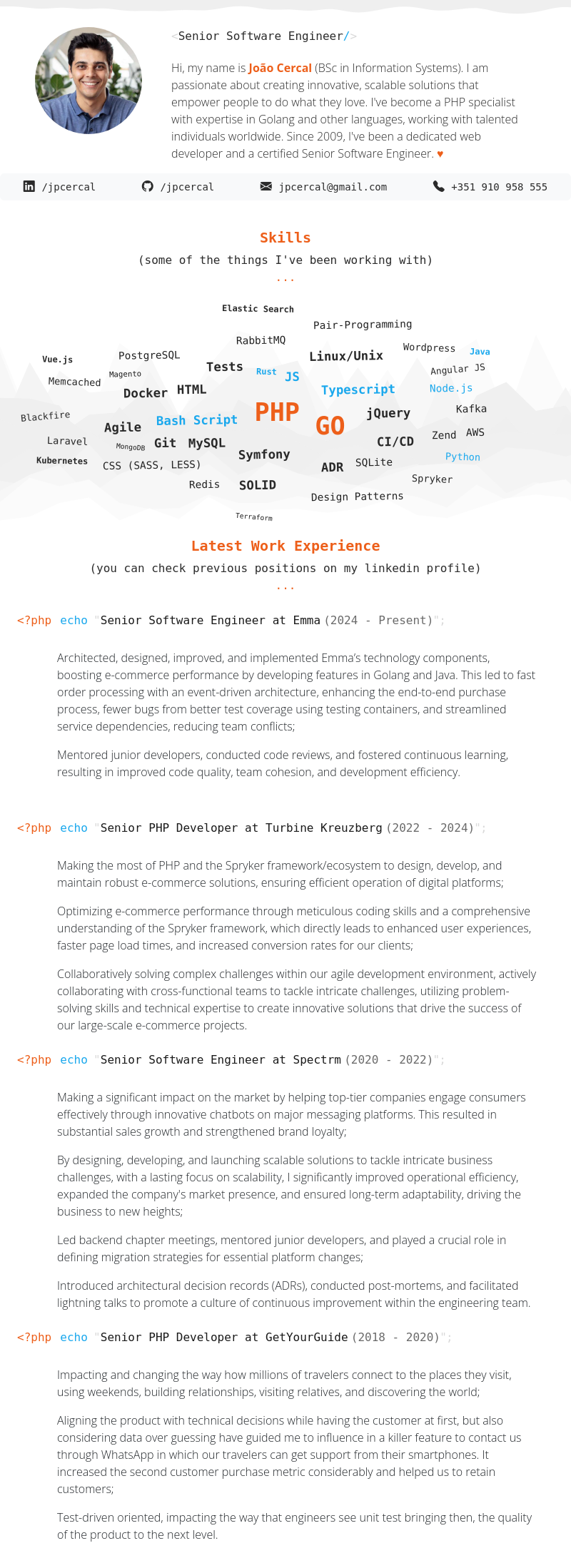As a software engineer with a thirst for adventure, I'm constantly seeking ways to enhance my skills and tackle new challenges. Recently, I embarked on a project to create a resume generator that utilizes JSON resume schema files to produce polished PDF resumes. This project allowed me to delve into the world of resume automation, exploring both its potential benefits and potential pitfalls.
At the very top of the document, you can click on the João's Resume | VIEW
button to view João's resume in PDF format. Additionally, you can click on the
João's Resume | DOWNLOAD button to download a copy of the resume for offline
viewing.
For the tech-savvy, the detailed information is stored in the JSON file resume.json, you can see a preview of how this file looks like below:
And, of course you are welcome to check the workflow jobs on
.github/workflows/resume.ymlor simply click on Github Actions to see the workflow in action.
To run this project locally, you will need to install the following dependencies:
- Docker
Once you have the required dependencies installed, run the following commands from the root directory of the project:
docker build --tag jpcercal/resume .
docker run -it --rm -v $(pwd):/app jpcercal/resume npm installOnce the docker image is built, you can apply the changes to the resume and re-render the pdf document using the following command:
docker run -it --rm -v $(pwd):/app jpcercal/resume npm run buildThis will create two files on the root directory, namely they are:
- resume.html
- resume.pdf
Enjoy it. =)
To fully appreciate the project's potential, let's first gain a grasp of the groundwork that has already been laid.
The heart of this project lies in a file named resume.json, which serves as
the source of truth for the generated resume.pdf. This file contains
meticulously crafted JSON data, outlining my educational background,
professional experiences, skills, and other relevant information. To ensure the
integrity of this data, I used the
resumed library, a powerful tool for
validating JSON resume schema compliance.
After validating the resume.json file, the resumed library kicks off the
next phase: generating the HTML template for the resume. This template serves as
the foundation for the final PDF document, ensuring a consistent and visually
appealing layout. The HTML template is then fed into
puppeteer, a headless browser automation library, which
takes care of rendering the HTML content and generating the PDF file.
The allure of this project lies in its ability to automate the tedious task of generating PDF resumes. This automation has several advantages:
-
Consistency and Accuracy: By relying on automated processes, we can ensure that every resume produced adheres to a consistent format and contains accurate information. This eliminates the risk of human error and ensures a professional presentation.
-
Efficiency and Time Savings: Automating the resume generation process saves a significant amount of time and effort. Instead of manually crafting each PDF, we can focus on more strategic content creation and job search activities.
-
Navigating the Challenges: Cons of the Approach While the benefits of automation are undeniable, there are also some potential drawbacks to consider:
-
Data Dependency/validation: The success of this approach hinges on the accuracy and completeness of the resume.json data. Any inconsistencies or missing information will directly impact the generated PDF.
-
Technical Expertise: Implementing and maintaining this automation pipeline requires a certain level of technical proficiency. Developers with experience in JSON, HTML, and headless browser automation will be well-equipped for this task. Although anyone can easily edit the resume.json file, which is all that is needed.
-
Customization Flexibility: While the template generated by resumed provides a solid foundation, it may not always align perfectly with individual preferences. Some users may require more customization options to achieve the desired look and feel. But, it's easy to do, just install any template or extend the one from this project which lives under the folder
theme.
This resume generator project has been an exciting journey into the world of automation and resume creation. It's gratifying to have developed a tool that can streamline the resume-building process and enhance the overall job search experience. While there are challenges to consider, the benefits of automation make it an attractive approach for many. As a software engineer, I'm eager to continue exploring automation techniques and expanding my skillset.





